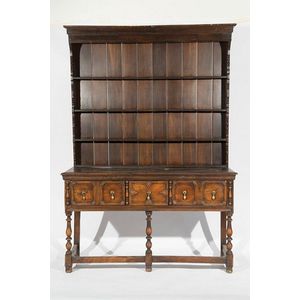Jacobean Oak Dresser with Marble Top, 19th Century English
You must be a subscriber, and be logged in to view price and dealer details.
Subscribe Now to view actual auction price for this item
When you subscribe, you have the option of setting the currency in which to display prices to $Au, $US, $NZ or Stg.
- Jacobean - Jacobean is the name applied to the style of furniture and decorative arts in vogue from about 1600 to 1630 which includes the reign of James I (1603-1625). The most common timber used is oak, and it is ornamented with turning and elaborate carving. Characteristic of decoration of furniture in this style are bun feet, mortice and tenon joints (replacing dowell joints) and 'X' frame chairs.
The style was revived in the 19th furniture (Jacobean Revival or "Jacobean style") as represented by most of the furniture coming onto the market in Australia, that is described as "Jacobean". - Oak - Native to Europe and England, oak has been used for joinery, furniture and building since the beginning of the medieval civilisation. It is a pale yellow in colour when freshly cut and darkens with age to a mid brown colour.
Oak as a furniture timber was superceded by walnut in the 17th century, and in the 18th century by mahogany,
Semi-fossilised bog oak is black in colour, and is found in peat bogs where the trees have fallen and been preserved from decay by the bog. It is used for jewellery and small carved trinkets.
Pollard oak is taken from an oak that has been regularly pollarded, that is the upper branches have been removed at the top of the trunk, result that new branches would appear, and over time the top would become ball-like. . When harvested and sawn, the timber displays a continuous surface of knotty circles. The timber was scarce and expensive and was used in more expensive pieces of furniture in the Regency and Victorian periods.
This item has been included into following indexes:
Visually similar items

A late Victorian country oak George III style dresser, the plate rack back of four shelves and shaped aprons includes a pair of small doors and drawers, the open base with three short drawers, raised on shaped legs with pad feet. 164 cm x 47 cm x 189 cm

Early 18th century oak Welsh dresser moulded cornice, four plate shelves the base with three geometric panel drawers, baluster legs joined by plain stretchers (later back panels)

A late 19th century, Dutch walnut and marquetry astragal glazed vitrine 134.5 x 210.5 x 26 cm, veneer losses

A fine William and Mary oyster veneered walnut chest on stand, the stand probably 19th century, 142 cm high, 102 cm wide, 59 cm deep
